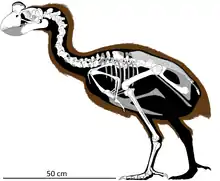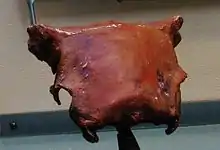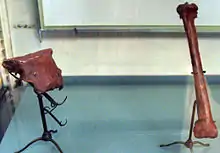Sylviornis
Sylviornis is an extinct genus of stem[1]-galliform bird containing a single species, S. neocaledoniae, or erroneously, "New Caledonian giant megapode". Technically, the latter is incorrect because it has recently been found not to be a megapode, but one of two genera in the family Sylviornithidae; at the time of its description, it was believed to be a ratite. Sylviornis was never encountered alive by scientists, but it is known from many thousands of subfossil bones found in deposits, some of them from the Holocene, on New Caledonia and the adjacent Île des Pins. Recent morphological studies indicate that it was a sister taxon of Megavitiornis, in a clade outside of the Galliformes crown group.[1]
| Sylviornis Temporal range: Holocene | |
|---|---|
 | |
| Sylviornis skeletal reconstruction, with known pieces in white | |
| Scientific classification | |
| Kingdom: | Animalia |
| Phylum: | Chordata |
| Class: | Aves |
| Family: | †Sylviornithidae |
| Genus: | †Sylviornis Poplin, 1980 |
| Species: | †S. neocaledoniae |
| Binomial name | |
| †Sylviornis neocaledoniae Poplin, 1980 | |
Description

Sylviornis was a huge flightless bird, 1.7 m (5.6 ft) long altogether, and weighing around 30 kg (66 lb) on average. It is the most massive galliform known to have ever existed. It had a large skull with a high and laterally compressed beak surmounted by a bony knob. Its legs were rather short, but had strong toes with long nails. The skeleton has a number of peculiarities and differences that make Sylviornis stand apart from all other known birds: the clavicles were not fused to a furcula, the number of caudal vertebrae was very high, and the ribcage and pelvis were almost dinosaurian in appearance. The wings were reduced to small stubs.
Behaviour
A large proportion—up to 50% in some deposits—of the remains found were from juvenile animals. Thus, it has been theorized that Sylviornis had a clutch of at least two, more probably closer to 10 eggs, and that the average lifespan was not much more than 5–7 years, which would be extremely low for such a large bird. It was thought that the bird did not incubate its eggs but built a mound similar to the megapodes. Tumuli on the Île des Pins which were initially believed to be graves were found to contain no human remains or grave goods, and it has been hypothesized that they were in reality the incubation mounds of Sylviornis. As these mounds are up to 5 m (16 ft) high and 50 m (160 ft) wide even after nearly four millennia, they seem too large to have been made by the giant scrubfowl (Megapodius molistructor), an extinct New Caledonian species of megapode.

However, recent assessment of this bird as outside and not even particularly closely related to megapodes make the possibility that it was a mound-builder like them strictly unlikely.[1]
Ecology
Little can be said about the lifestyle of Sylviornis. It was probably a slow-moving browser, and the structure of the bill and feet suggest that roots and tubers it dug up formed a major part of its diet.
Extinction
The bird was hunted to extinction by the Lapita ancestors of the Kanak people, who settled New Caledonia around 1500 BC.[2] Predation by feral dogs and pigs probably also played a part. The legacy of Sylviornis persists in Kanak oral history in the form of stories giving a rough description of the bird and some of its habits. The native name was du.
See also
- Biodiversity of New Caledonia
- Holocene extinction
- Island gigantism
- Late Quaternary prehistoric birds
References
- Worthy, T.; Mitri, M.; Handley, W.; Lee, M.; Anderson, A.; Sand, C. (2016). "Osteology supports a steam-galliform affinity for the giant extinct flightless birds Sylviornis neocaledoniae (Sylviornithidae, Galloanseres)". PLOS ONE. 11 (3): e0150871. doi:10.1371/journal.pone.0150871. PMC 4814122. PMID 27027304.
- Anderson, A.; Sand, C.; Petchey, F.; Worthy, T. H. (2010). "Faunal extinction and human habitation in New Caledonia: Initial results and implications of new research at the Pindai Caves". Journal of Pacific Archaeology. 1 (1): 89–109. hdl:10289/5404.
- Mourer-Chauviré, Cécile; Balouet, J. C. (2005). "Description of the skull of the genus Sylviornis Poplin, 1980 (Aves, Galliformes, Sylviornithidae new family), a giant extinct bird from the Holocene of New Caledonia". In Alcover, J. A.; Bover, P. (eds.). Proceedings of the International Symposium "Insular Vertebrate Evolution: the Palaeontological Approach". Monografies de la Societat d'Història Natural de les Balears. 12. pp. 205–218.
- Poplin, François (1980). "Sylviornis neocaledoniae n. g., n. sp. (Aves), ratite éteint de la Nouvelle-Calédonie". Comptes Rendus de l'Académie des Sciences, Série D (in French). 290: 691–694.
- Balouet, Jean-Christophe; Olson, Storrs L. (1989). "Fossil Birds from Late Quaternary Deposits in New Caledonia" (PDF). Smithsonian Contributions to Zoology. 469 (469): 1–38. doi:10.5479/si.00810282.469.
- Worthy, Trevor H.; Mitri, Miyess; Handley, Warren D.; Lee, Michael S. Y.; Anderson, Atholl; Sand, Christophe (30 March 2016). "Osteology supports a stem-galliform affinity for the giant extinct flightless birds Sylviornis neocaledoniae (Sylviornithidae, Galloanseres)". PLOS One. 11 (3): e0150871. doi:10.1371/journal.pone.0150871. PMC 4814122. PMID 27027304.
